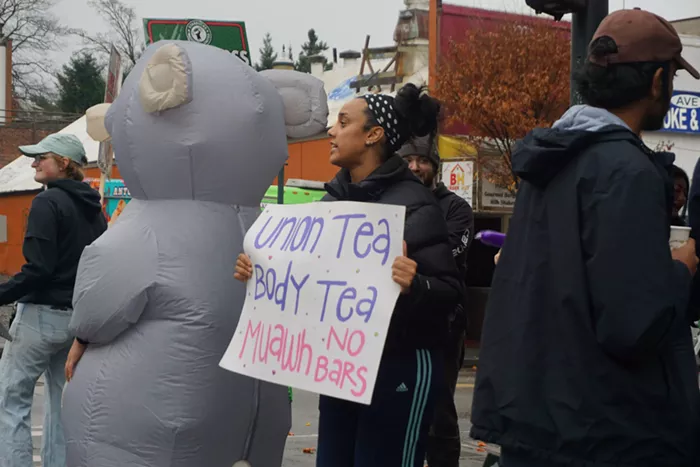This post was originally published on this site
At 9 a.m. Thursday morning, at what’s usually a busy time of day for a coffee shop, the U-District Starbucks was locked up. Lights out, chairs on tables, and empty inside.
Outside, about 25 union baristas and their supporters lined the sidewalk. The same scene was playing out in Queen Anne (1144 Elliott Ave W), Portland, Chicago, Pittsburgh, New York City, and others. Thousands of employees at 40 stores nationwide are on strike after Starbucks went six months without offering new bargaining proposals, and more than 18 months after national contract bargaining began.
Cars honked as picketers chanted a remix of Chappell Roan’s HOT TO GO!, shouting, “H-O-T-T-O-G-O, union busting’s got to go!” They carried signs that read, “Don’t cross our picket line” and “No contract? No coffee!” Their march circled a protester in an inflatable Remy (the rat) costume.
Emma Cox, a seven-year Starbucks barista, union leader, and strike captain, says the strike is the result of more than a year of corporate’s bad-faith bargaining and union-busting measures, including store closures and write-ups for policy violations Starbucks Workers United (SBWU) never bargained over. These actions violate labor laws, Cox says.
Shuttering unionized stores is Starbucks’s most egregious union-busting measure, Cox says. In September, the company shut down the Starbucks Reserve Roastery on Capitol Hill, a store that was active in the union. One in Eastlake closed this year, too. The worst of it was 2022’s citywide wave of closures.
Starbucks’s other union-busting methods—its new policies that were unilaterally implemented—include a stricter dress code for employees and no free water or bathroom access for non-paying visitors. Union members report that employees are being written up for breaking the new policies.
“[Starbucks] hasn’t bargained for any of those policies, but they have been enforcing them and writing people up,” Cox says. “That in itself is a ULP that’s happening at every single union store in the country.”
Cox says since the beginning of this year, SBWU has filed about 125 new unfair labor practice (ULP) complaints, on top of the about 700 unresolved from previous years, largely based around bad-faith bargaining, unilateral policy changes, and retaliatory firings and discipline. Administrative law judges at the National Labor Relations Board found that Starbucks has committed more than 400 labor law violations—the “biggest violator of labor law in modern history,” the union says.
At the bargaining table, SBWU has been asking for higher pay, adequate staffing, and increased hours so employees can qualify for benefits.
Cox says it would only take $75 million for Starbucks to settle the contract with the union. They say that’s less than the $96 million CEO Brian Niccol made in his first four months with the company last year and the $81 million Starbucks spent on a management conference in Las Vegas this September.
The picket wrapped around 11 a.m., and Cox urged people to sign the No Contract, No Coffee pledge.
“It feels like we’re just going in a completely wrong direction,” Cox says. “If [Starbucks] just sat down with us, settled our contract, that would get the company moving in the right direction.”
A rally is planned for today at 4 p.m. outside the Starbucks Reserve Roastery.
In an email to The Stranger, Starbucks Director of Global Communications Jaci Anderson writes the company is “actually having a great day.” Ninety-nine percent of their coffeehouses remain open, and they’re seeing “extremely limited impact in Seattle,” she writes.
“In the event a coffeehouse experiences a temporary closure as a result of Workers United’s actions, I can assure you there will be stores nearby open,” she writes. “We have plenty of Red Cups to give away and are excited to have a great day with our customers.”
Anderson writes that Starbucks is disappointed that the union (which she represents less than 4 percent of their employees) called for a strike instead of returning to the bargaining table. She writes that the union left the bargaining table in April, despite almost 200 hours of negotiations and more than 30 tentative agreements reached. (The union disagrees with this characterization of events.)
“When the union is ready to come back to the bargaining table, we’re ready to talk,” Anderson writes.
